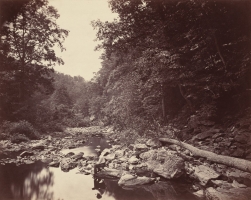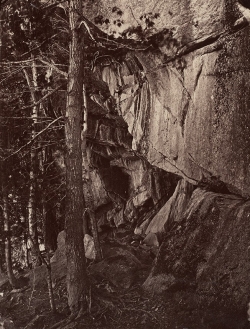Exchanges between landscape artists and photographers in the mid-nineteenth century moved the new medium toward more aesthetic concerns.A number of photographers — including John Moran and Charles and Edward Bierstadt — had close ties to the art world and worked side by side in nature with painters, while others often chose the same picturesque sites beloved by artists. Although photographers sometimes sought to adapt traditional ways of presenting landscape, they also explored new modes of composition that were tied to effects associated with photography, such as a cropped field of vision or flattened perspective.
Photography and Painting: 1850s–1860s

The British art critic John Ruskin inspired a generation of artists to paint with painstaking precision, exhorting them to scrutinize nature,“rejecting nothing, selecting nothing,and scorning nothing.” Photography, which could meticulously reproduce details, fostered just such an aesthetic, and some practitioners turned to the close study of nature. Through the work of Moran, Bierstadt, and others, eastern landscape photography cohered as an artistic endeavor. Allying the medium more firmly to contemporary developments in painting, they thereby helped develop a burgeoning market for landscape photographs.
Above: John Moran, American, born England, 1831–1902, The Wissahickon Creek near Philadelphia, c. 1863, albumen print, National Gallery of Art, Washington, Horace W. Goldsmith Foundation through Robert and Joyce Menschel
Below: Charles Bierstadt, American, born Prussia, 1819–1903 and Edward Bierstadt, American, born Prussia, 1824–1906, The Cathedral, White Mountains, New Hampshire, c. 1860, albumen print, The Nelson-Atkins Museum of Art, Kansas City, MO, Gift of Hallmark Cards, Inc., 2005.27.250
